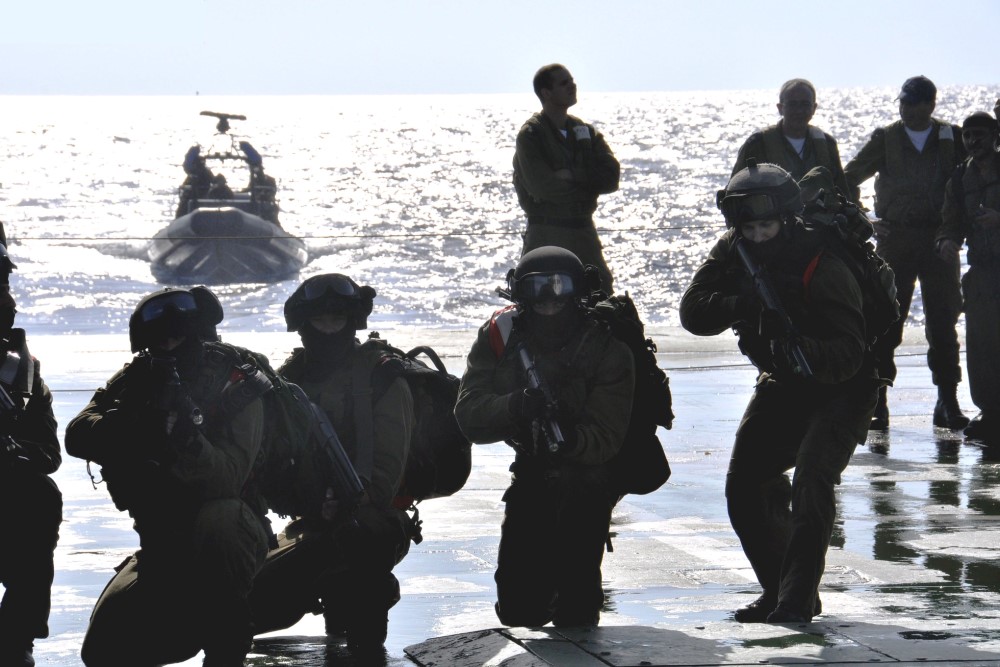
Israel just added a formidable weapon to its diverse military arsenal: The Navy’s new landing craft docked at the Haifa port after a long journey from the US. A second craft will be arriving later, and both will be upgraded with Israeli-made systems and technology.
The new vessel significantly boosts Israel’s capacity to stage amphibious assaults across the Middle East. The craft will further diversify IDF capabilities, while complicating the calculations and plans of Israel’s enemies.
Looking forward, one of the prime targets for landing would be Lebanon during a large conflict with Hezbollah. This would enable the IDF to quickly transfer forces and equipment into enemy territory via a new route. But can Hezbollah intercept the craft before it reaches Lebanon’s shores?
Protecting the craft
Intercepting the Israeli landing craft would likely be a substantial challenge for Hezbollah. Modern military vessels, including crafts, have various defensive capabilities and operate under the protection of other naval and air assets during transit and landing operations, especially in a conflict scenario.
Some factors to consider: The Israeli landing craft will be equipped with defensive systems to counter potential threats. Such protective measures will include sophisticated electronic warfare components to disrupt Hezbollah’s ability to engage the vessel.
Routes, timing, and deployment methods will be meticulously planned to mitigate risks. This may include decoys and diversion tactics to deceive Hezbollah. Moreover, the IDF will use advanced surveillance and reconnaissance gear to detect potential threats. Such early detection would allow the craft and its escorts to react and adapt quickly.
However, some factors may play in Hezbollah’s favor: The group has a large arsenal of anti-ship and anti-tank missiles as well as modern surveillance equipment to monitor the coast. Hezbollah may also receive intelligence tips from Iran and possibly Russia, which has increasingly aligned itself with Tehran and its allies.
Moreover, landing crafts are subject to limitations based on geography, topography, and tides, which restrict the number of suitable landing sites. They are typically designed to land on a variety of shore types, but factors such as beach gradient, underwater obstacles, and the shoreline’s nature (sandy, rocky) can impact where a landing can successfully occur.
Mining Lebanon’s shoreline?
To counter an amphibious assault, Hezbollah would have to focus on likely landing spots, use intelligence and analysis to predict where Israeli forces might land, and rapidly deploy fighters to respond to a seaborne raid. The group might also fortify potential landing spots and mine approaches to beaches.
Hezbollah would also use the local terrain and civilian population to its advantage, integrating its forces within residential areas to mitigate the impact of superior Israeli power.
Still, it would be a considerable logistical and tactical challenge for Hezbollah to defend Lebanon’s coastline effectively, especially against superior forces. In a full-scale war, Hezbollah will be under massive attack on multiple fronts and will struggle to respond to every threat in a timely manner while drawing on limited resources.
Hezbollah’s wartime test
Even if Israel does not mobilize a landing craft, its very presence would disrupt Hezbollah’s war preparations. Diverting forces, equipment, and intelligence assets to defend against potential amphibious landings would weaken Hezbollah’s defenses on other fronts.
But if the IDF does deploy its craft, responding to it effectively under war conditions would be difficult. Hezbollah will be under heavy aerial bombardment supplemented by artillery fire on several fronts. Israel will also deploy warships on strike missions plus armored and special forces, possibly at unexpected locations deep inside Lebanon.
Moreover, Hezbollah’s best forces will be deployed on the border to attack Israeli targets and stop invading IDF troops.
Engaging the various arms of Israel’s massive war machine would be an extreme challenge, impacting response times and effectiveness. Hezbollah would likely find itself stretched thin, defending against multi-front assaults as it comes under attack from the air, land, and sea. Monitoring and defending the shoreline under such conditions is not a simple task.
The bottom line: While the geographic and topographic limitations of an amphibious landing may allow Hezbollah to concentrate defenses more effectively, achieving this under the pressure of large-scale combat is a formidable task. Given the IDF’s superiority in every dimension, Hezbollah may achieve some tactical wins while facing serious setbacks on all fronts, including the maritime theater.


